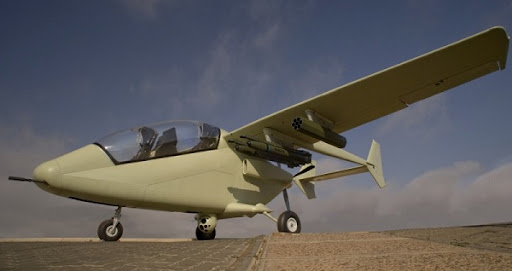I was interested to read about a new aircraft project in South Africa. AHRLAC (Advanced High-performance Reconnaissance and Surveillance Aircraft) is described as follows:
Aerosud has always held the view that Unmanned Aerial Vehicles (UAV) will continue to play a key role in aerial reconnaissance and surveillance, but UAV’s are characterised by a number of constraints, including high acquisition cost, control complexity, control link security, limited payload capacity, difficulties associated with operation in Air-Traffic-controlled zones etc. and also requiring a large 'logistic footprint' for deployment and control.
A study was launched into the viability of developing a low-cost yet high-performance manned alternative to UAV’s, which resulted in the launch of a totally new aircraft optimised for this role and today known as AHRLAC (Advanced High Performance Reconnaissance and Surveillance Aircraft). Design characteristics include self-deployment to and from semi-prepared strips coupled to high cruise speed and much extended range and loiter capability. The aircraft will be optimised for multiple missions via the carriage of payload combinations including FLIR, SAR radars, COMINT and ELINT sensors etc, all integrated with an advanced avionics suite optimised for both onboard display as well as data relay. The total payload capability (excl. fuel and crew) is around 800 Kg [1,760 pounds].
Developed in close partnership with the South African Paramount Group, leaders amongst others in Land Systems, the AHRLAC mission definition focuses on “Homeland Security” covering applications such as border security, coastal and maritime/EEZ patrol, the combating of piracy, drug traffic control etc. and crew and mission protection is playing a major role in the design.
There's more at the link. There's a news article about AHRLAC here, and a CGI video clip may be found here.
The aircraft sounds somewhat similar to the Northrop Grumman Firebird, which we've examined before in these pages. However, Firebird is optionally manned, allowing it to function as a fully-fledged UAV if necessary, whereas AHRLAC (they really need to figure out a better name for this bird!) is (at least currently) a two-seater. I don't know whether or not there are plans to develop it into an optionally piloted or unmanned version as well. Furthermore, Firebird only carries a sensor payload at present, whereas AHRLAC will be able to carry weapons too. The image below shows it with a 20mm. cannon protruding from its nose, and two Mokopa anti-tank missiles and a canister of unguided rockets beneath its wing.

AHRLAC's pricing looks interesting. The Beechcraft T-6 Texan II turboprop trainer, used by the USAF, is being sold to Iraq for a unit price of approximately $14 million. That figure includes training and maintenance packages, making the actual cost per aircraft probably $8-$10 million. A light attack version of this aircraft, known as the AT-6B Texan II, is under development. It sounds as if it'll be comparable (perhaps superior) to the AHRLAC in capability, but will presumably cost more than the trainer version of the T-6. Brazil's Embraer EMB 314 Super Tucano, an equivalent to the AT-6B, sells for $9 million according to this report. The AHRLAC is reportedly on the market for $10 million apiece, which puts it in the right ballpark. If its sensor and weapons fit is sufficiently advanced and comprehensive, that may even be a bargain price. An order for 50 aircraft has reportedly already been placed by an unnamed customer, although I'll be inclined to trust that news only when I see aircraft being delivered!
There's no prototype of AHRLAC yet, but a full-size mockup has been built, and a radio-controlled scale model has flown. First flight is expected next year. If this is built 'African tough', able to take the pounding of unprepared airstrips and mistreatment by ham-handed pilots, it might be a very useful tool for many smaller Air Forces in the Third World.
Peter


2 comments:
Looks a lot like a two-seat version of the Sadler Piranha, though the Piranha is optimized for close air support rather than recon.
As for the name, call it the Special Advanced High Performance Reconnaissance and Surveillance Aircraft, or SAHRLAC. The spelling should be just different enough to keep Lucas' lawyers at bay... And if not, this version has laser guided anti-tank missiles!
Anybody that thinks that an unmanned aerial vehicle costs more to field and has a larger logistical footprint and tail is either foolish or lying to support an agenda.
The design limitations forced upon aircraft builders to support a fragile human in the cockpit and use MK1 eyeballs as prime sensor drives enormous compromises in payload, lift, acceleration, turning capability etc.
Eliminate the plexiglass and ejection seat and pressurization and oxygen and human/ aircraft user interface ( Dials and switches and joysticks and HUDs) and you can build phenomenal capabilities into the drone.
Price plummets per unit and economy of scale can come alive in production.
Have you seen the number of knuckleheads required to field a small chunk of a fighter wing deployment? Add an AWACS into the mix so you can actually have some air superiority and the cost skyrockets.
OR you can build some UAVs that can be fielded by army grunts and controlled remotely.
BTW I am a retired UASF flyer type w/ 6500 hours of flight time under my belt.
Post a Comment